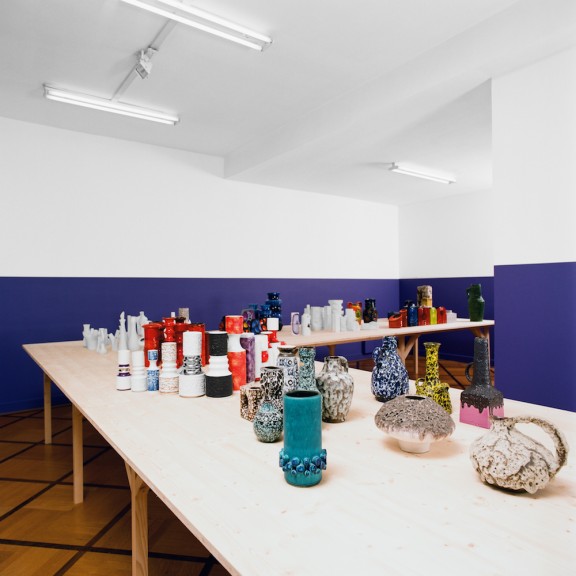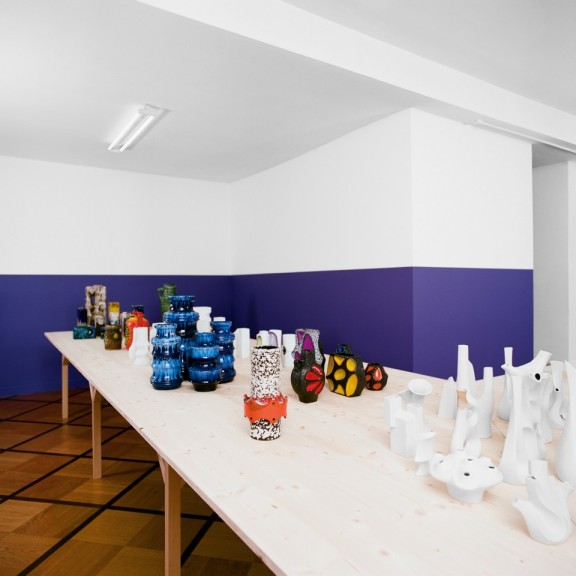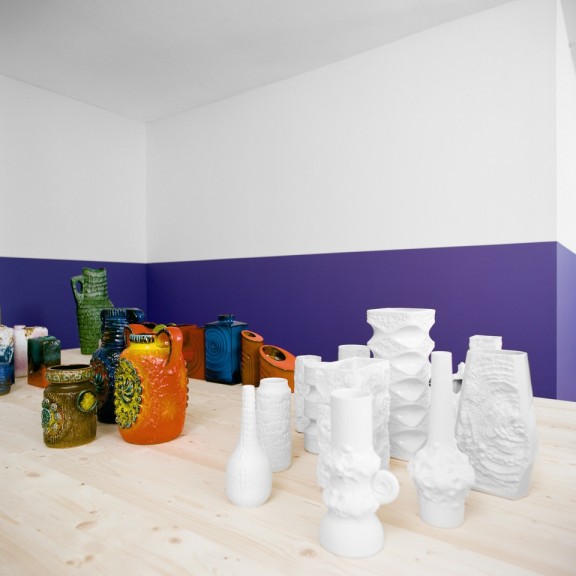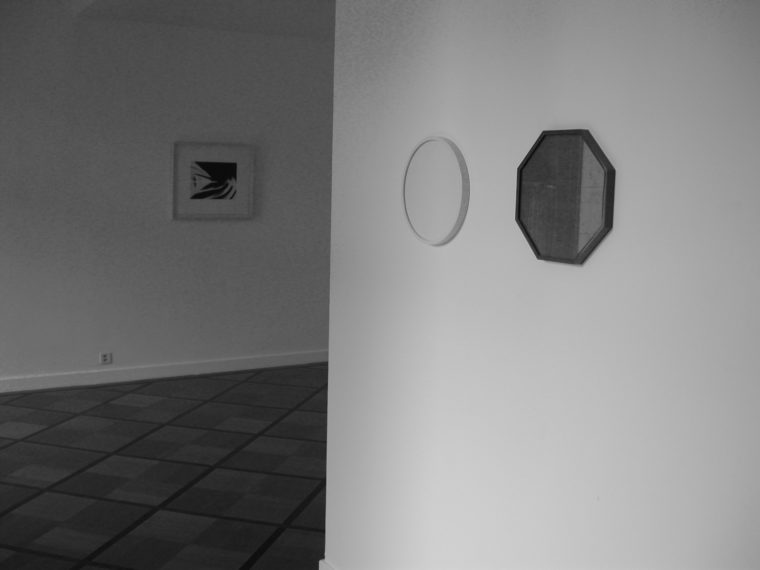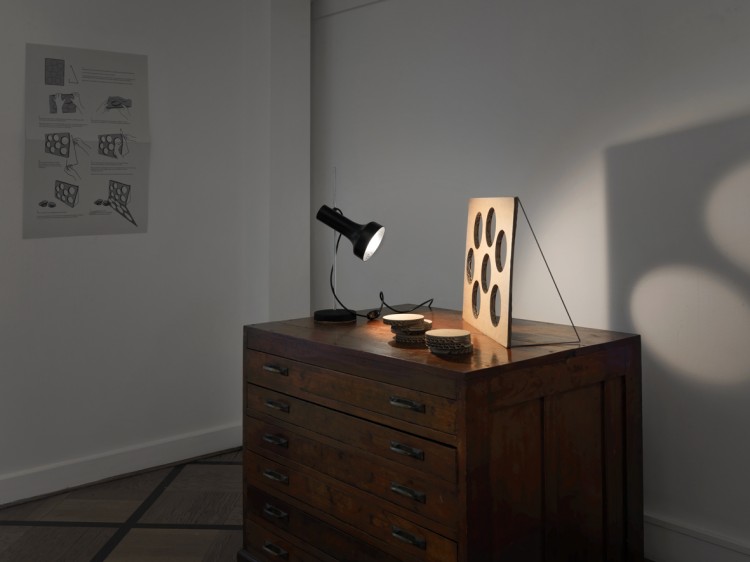Sgrafo vs Fat Lava
Céramiques et porcelaines Made in West Germany, 1960-1980
From November 5, 2010, until February 5, 2011
Opening on November 4, 2010, from 6pm
Céramiques et porcelaines Made in West Germany, 1960-1980
With a sound piece by Seth Price
For the beginning of the month of November 2010 with the exhibition of a collection of historical ceramics from the 1960s – 1980s, we will be crossing from the field of art into the field of the object, nevertheless not fully abandoning the first one to the second. Almost a hundred pieces covering different styles and production processes will let us discover through a utilitarian and decorative object the different aesthetic variations of a prolific and stylistically free period, when common taste allowed itself to be kitsch and delirious. An era before the supremacy of design that is going to format most of our daily objects.
The exhibition, entitled « Sgrafo vs Fat Lava, Ceramics and Porcelains Made in West Germany, 1960-1980 », is accompanied by a little book published for the occasion by JRP/Ringier (Zurich) in its « Hapax » series : Sgrafo vs Fat Lava.
Presenting this series of ceramics produced between the 1960s and the 1980s and often called Fat Lava or West German Ceramic/Pottery suggests an ironical and playful association with the field of edition. It underlines issues that are mutually and regularly discussed and that question the constant reevaluation between art and function, art and design, or even a certain know-how, especially since artists’ and designers’ recent interest in the revival of handicrafts.
The set suggested by curator Nicolas Trembley for his collection of ceramics and porcelains examines several notions. It considers questions of evolution in shapes and patterns, questions about the common taste, the decorative, the multiplicity of objects and their quasi-industrial or traditional production, reflects on collection as such and the transition from an ordinary object to a fetishized one. Transforming the exhibition space – literally by a work of « decoration » – will stage the particular and unwritten history of these ceramics.
This group of objects mixes without hierarchy good and bad taste, throws light on this eternal back and forth between a so-called « popular » taste and its appropriation by « vintage » and points at changing trends. It also examines the recurrent question of the crafts and the decorative shifting more or less recently into the field of contemporary art. Drawn by the obsessional research of a collector, it is an exotic and critical try to detect the ever vacillating and ever discussed limits between a thing that is « in » or very frankly « out », between sinking into oblivion or being revived, between common taste became artistic and chic.
In an easy manner, for the pleasure of the eyes and with a feeling of déjà-vu, we discover through this exhibition a nomenclature of forms and colours jollier, more uninhibited and amusing than the one belonging to ordinary art history. The aesthetics of these vases are playing with the typical and even folklore. In parallel, in the 1960s – 1980s, the most productive period, the spirit of the seventies with its return to nature favoured textured surfaces, imitating shells, barks and fossils. Though some more minimalistic forms, inspired by Bauhaus, structure the construction of these objects (vases, pots,…), their decorative language remains closer to Pop and Op-Art than to pure minimalism. Some pieces reveal a more « futuristic » inspiration, in immaculate white enamel recalling Pierre Cardin creations, Jacques Tati sets or Jean-Christophe Averty tv-animations (for the very Pop ones).
« But all vases aren’t the same. If some of them have an insignificant appearance others are simply extraordinary and cleary more innovative than actual design. During forty years in the very heart of an economic boom, creators enjoyed unprecedented freedom. […] The designers have succeded in capturing the spirit of the times in its forms, referring to the Cubism of Braque or the Op-Art of Vasarely for example. Design becomes more geometric and borrows the fluid lines and the primary colours from Verner Panton or some futuristic shapes from science fiction and flying saucers. The soft Hippie movement and political protest finds its formal expression in biomorphic vases recalling the psychedelic architecture of Antti Lovag or minor and hand-crafted production of macramé and pieces out of streched-out threads. The spiritual quest of the time, the attempt of a return to nature are echoed by vases with a decor evoking cosmogony, imitating tree barks, mushrooms and cristals, the aspect of fossils and stones, the depths of oceans – shells and corals. Other designers refer to experimentations of modernist Bauhaus architecture and create brutalist objects covered in roughcast.
It is without doubt the famous glaze today called « Fat Lava » that characterizes this production. Made out of several layers of enamels and chemical components reacting variously to fire, this technique engenders a surface of lava flows and craters. From then on, German ceramics take the road of a peculiar decor that reaches unique swellings and plastic exaggerations in the history of forms. »
(Quoted from Nicolas Trembley’s introduction to the book Sgrafo vs Fat Lava, published by JRP/Ringier in the collection Hapax, and edited at the occasion of the exhibition at the CEC.)
A book, Sgrafo vs Fat Lava, linked to the display of this particular collection is published for this occasion by JRP/Ringier in the « Hapax » series. The book will be launched at the Centre d’édition contemporaine during the exhibition. It comprises an introduction by Nicolas Trembley – Madeleine de Proust et Fat Lava –, a discussion between French designer Ronan Bouroullec and Nicolas Trembley, an essay by an art historian specialized in the history of German ceramics of the 1950s, Horst Makus with Formes, couleurs et décors, un survol. It also shows around twenty
reproductions of the historically, technically and stylistically most significant models produced by these factories of Southern and Western Germany.
Curator of the exhibition : Nicolas Trembley
The exhibition is presented at FRAC Champagne-Ardenne, Reims, from March 18 until April 24, 2011, and at the Galerie Kreo, Paris, from May 20 until July 23, 2011.
The Publication :
Sgrafo vs Fat Lava
Book, French, bound, 105 x 165 mm, 64 pages, 22 colour pictures. Summary : Nicolas Trembley (ed.), Madeleine de Proust et Fat Lava (introduction); text by Horst Makus, Formes, couleurs et décors. Un survol; Interview of Ronan Bouroullec by Nicolas Trembley. Graphic design : Gavillet & Rust / Eigenheer, Geneva. Publisher : JRP|Ringier (Hapax collection), Zurich, 2011. ISBN 978-3-03764-163-7.
Sgrafo vs. Fat Lava
Book, English, bound, 105 x 165 mm, 64 pages, 22 colour pictures. Summary : Nicolas Trembley (ed.), Proust’s Madeleine and Fat Lava (introduction); text by Horst Makus, Form, Color, and Decoration: An Overview; Interview with Ronan Bouroullec by Nicolas Trembley. Graphic design : Gavillet & Rust / Eigenheer, Geneva. Publisher : JRP|Ringier (Hapax collection), Zurich, 2012. ISBN 978-3-03764-277-1
